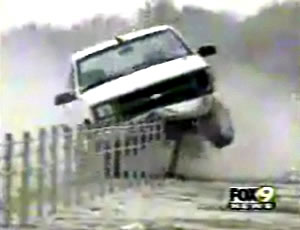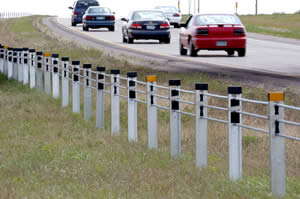 |
Pictured here is a vehicle stopped by a cable median barrier during a controlled test. In mid-July, KMSP-TV news ran a story about the effectiveness of the barriers now in place on some interstate stretches in the Metro District and District 3. Click here to view the full broadcast of the cable barriers. Video image courtesy of KMSP-TV
|
After spinning out of control on northbound Interstate 94 near St. Michael last winter, an SUV veered toward the median and the southbound path of a District 3 snowplow.
But instead of crossing the median and colliding with the plow, the SUV came to a gradual stop on its side of the freeway after being snagged by a barrier that uses high-tension steel cables to prevent median cross-over crashes.
“The plow operator said he was certain the SUV would have crashed into him were it not for the barrier,” said Gary Dirlam, District 3 traffic engineer.
Dirlam and John Hanzalik, supervisor at the Metro District’s Maple Grove truck station, don’t know the precise number of cross-over crashes the barriers avoided, but they do know more than 50 vehicles have hit the barriers located on I-94 and on a section of Hwy 23 between Cold Spring and St. Cloud since they were installed.
No fatalities occurred in those incidents, Hanzalik said.
The barriers are usually installed in highway sections that include entrance and exit ramps that lead to traffic weaving from lane to lane or a change in the number of lanes that can result in crashes or near-crashes than can send vehicles into median areas.
Their design enables the cables to flex when struck by a vehicle, absorbing much of a crash’s kinetic energy that slows the vehicle and keeps it from crossing the median or bouncing back into traffic.
In addition to their ability to lessen crash severity, the cable barriers cost much less than permanent, concrete barriers.
When a vehicle hits a section of cable barrier, maintenance crews can repair the damaged section quickly. The barriers are carried on steel posts that slide into concrete sleeves. If the barrier is damaged, the posts slide out easily to allow a new cable section to be installed.
Dirlam and Hanzalik are convinced of the barriers’ value and their ability to prevent of cross-over crashes that frequently result in life-changing injuries or deaths. So are Metro District managers who have approved adding 10 miles of cable barriers in the Twin Cities metropolitan area. Maintenance crews will install additional barrier sections on I-94 in Brooklyn Center, I-35W in Burnsville and on Hwy 169 and I-494 in Plymouth next year.
Cable barriers are now in use on I-94 at interchanges in Albertville and St. Michael by District 3 and between the I-94/694 and the I-494 interchange to the Crow River south of Rogers .
 |
Cable median barrier along I-94 in Maple Grove was installed late spring 2004. File photo by David Gonzalez |
Before Mn/DOT begins its second phase of cable installation, Dirlam and Hanzalik will join other transportation practitioners from the Upper Midwest in a FHWA-sponsored study tour to learn how other states such as Texas and Oklahoma have fared with their use.
When the installations’ second phase begins, the new barriers will have four strands of cable instead of three. Contractors will install an additional 10 miles of barriers on I-94 in Brooklyn Center, I-35W in Burnsville, Hwy 169 and I-494 in Plymouth
Nancy Yoo, a principal design engineer with the Metro District, said the four-cable design is capable of stopping an 18,000-pound, single-unit truck traveling at 50 miles per hour. That design meets test level 4 specifications compared with test level 3.
Test level 3 specifications require that cable barriers stop a 4,500-pound vehicle such as a pickup truck or SUV traveling at 62 mph.
Beverly Farraher, a Metro maintenance operations engineer, said the cable barriers have worked as designed.
“The barriers comprise a safety system that does what it’s supposed to do: prevent catastrophic, cross-median crashes. Our maintenance crews would rather repair damaged barrier sections than deal with the traffic tie-ups and other effects of a fatal crash,” she said.
By Craig Wilkins
|



